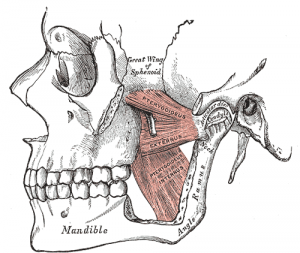Of all the areas of the body that I regularly adjust in my office, the jaw is the one that draws the most surprise from my patients. Many people don’t know that the jaw can get fixated, and that a chiropractic adjustment can restore the mechanics of the jaw.
The jaw has two joints (temporal-mandibular joints) each cushioned by a disc, and one or both can become problematic under the influence of stress, trauma, teeth grinding, poor head posture, or prolonged dental work. The issue is that the disc material can get entrapped either in front of or behind the hinge-like ends of the jaw bone (the condyles of the mandible). The clicking or catching feeling you may hear or feel is the condyle slipping past the trapped disc.

The rounded condyles of the jaw are shown on the far right of this picture.
On a side note, during an extremity adjusting seminar we had the opportunity to watch videos of surgical procedures showing several types of TMJ surgery. One surgery was to scrape out scar tissue that had built up around the disc that was preventing proper motion. Another surgery was to remove an entire damaged disc! It was amazing to see the texture of the disc material. It was not at all what I had imagined it would be. It stretched quite a lot and looked extremely sticky.
According to Dr. Hearon, an expert on extremity adjusting, you must have three of the following twelve symptoms to have a diagnosis of Temporal Mandibular Syndrome (TMS). If you have fewer than three of this list, you have Temporal Mandibular Dysfunction (TMD). So basically, your treatment will look similar, but you get a less-fancy diagnosis.
12 Major Signs/Symptoms of TMJ:
- Pain at the TMJ
- Crepitus (a grating sound) at the TMJ
- Bruxism (grinding the teeth, especially at night)
- Inability to open mouth more than 3 stacked fingers)
- Inablitiy to close teeth together
- Headaches
- Neck pain
- Tinnitis (ringing in the ears)
- Tracking deviation (jaw veers to one side upon open/close)
- Chronic recurring neck subluxations
- Muscle weakness in jaw movements
- Occular dysfunction (eye movement issues)
Depending on which direction the disc has slipped, there are two main jaw adjustments that a chiropractor can do that restore the function of the TMJ joints in order to decrease a patient’s jaw pain and other symptoms.
Do you experience three or more of the symptoms on this list? Schedule an appointment with your Oakland chiropractor to find out whether you have TMS, and to get started on treating it.
Photo credits: wiki commons
